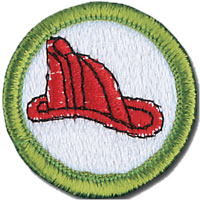Fire Safety


Resources
- Fire Safety Merit Badge Pamphlet
- Fire Safety Merit Badge Class Preparation Page
- Fire Safety Merit Badge Workbook
- Scoutmaster Bucky's Merit Badge Advancement Quick Reference
- Scoutmaster Bucky's Acknowledgement Form
Fire Safety Requirements
Current Scouts BSA requirements
as of December 21, 2025
as of December 21, 2025
1.
Science of and Hazards of Fire. Do the following:
a.
Explain the concept of fire.
b.
Name the parts of the fire tetrahedron and the products of combustion.
c.
Describe the life cycle of a fire.
d.
Explain the three methods of heat transfer.
2.
Fire Extinguishers. Do the following:
a.
Explain the different classes of fires.
b.
Identify the different classes of fire extinguishers and which should
be used for each class of fire.
c.
Demonstrate how to use a fire extinguisher and a fire blanket.
3.
Fire-related Injuries. Do the following:
a.
Explain and demonstrate the technique of stop, drop, roll, cool, and
call.
b.
Describe how clothing fires occur, how to prevent them, and how
clothing can prevent or contribute to burn injuries.
c.
Identify the most frequent causes of burn injuries and how to prevent
them.
d.
Review the prevention of, symptoms and signs of, and treatment of
airway burns and carbon monoxide (CO) poisoning.
4.
Origins of Fires. Do the following:
a.
Explain the four classifications of fire origin (natural, accidental,
incendiary, or undetermined) and give an example of each.
b.
Describe how a fire classified as incendiary might lead to criminal
prosecution of a person charged with arson.
5.
Fire Safety at Home. Do the following:
a.
Describe how to prevent the frequent causes of home fires, including
unattended cooking, electricity, smoking, clothes dryers, and
rechargeable batteries.
b.
Describe how to prevent frequent causes of seasonal and holiday-related
home fires, including fires related to home heating, holiday trees,
candles, and fireworks.
c.
Demonstrate how to safely light and extinguish a candle. Discuss with
your counselor, then with your family, how to safely use candles.
d.
Using the Home Fire Safety Checklist in the Fire Safety
merit badge pamphlet or one approved by your counselor, and with
the help of an adult, inspect a home (or a similar building near
where you live or at a camp) for fire safety hazards. Present your
completed checklist to your counselor and discuss your findings.
e.
Determine if, and what types of, smoke and CO alarms are required in
homes in your community. List what types of smoke and CO alarms your
home has, their locations, and their expiration dates.
f.
Demonstrate maintenance of smoke and CO alarms to your counselor and
review plans to replace expired alarms.
g.
Develop a home fire-escape plan and a fire-drill schedule with your
family, draw a floor plan of your home with exits marked and a map
showing your family meeting point, and conduct a home fire drill.
h.
Explain what to do and what not to do if you smell natural gas and if
you smell smoke.
i.
Explain how you would report a fire to have the fire department
respond.
6.
Safety with Flammable and Combustible Liquids. Do the following:
a.
Explain what flammable and combustible liquids are commonly used in
homes and how to safely store them.
b.
Describe the safe way to refuel a liquid-fueled engine, such as a lawn
mower, outboard motor, farm machine, or automobile with fuel from an
approved container.
c.
Describe the options available for safely disposing of unwanted
flammable, combustible, and hazardous substances in your community.
7.
Fire Safety in Public Buildings. Do the following:
a.
Explain how public buildings are designed for fire safety.
b.
Explain what fire safety systems and equipment can be found in public
buildings.
c.
Explain what fire safety precautions you should take when you are in a
public building.
8.
Fire Safety at Camp. Do the following:
a.
Explain how the Leave No Trace Seven Principles apply to camping fires.
b.
Demonstrate lighting a match safely, the proper way to extinguish it,
and to dispose of it. Explain the similarities and differences between
safety matches and strike-anywhere matches.
c.
Explain and demonstrate making sparks with flint and steel or with a
ferro rod and catching a spark to create a flame. Extinguish the flame
safely using one of the principles of the fire tetrahedron.
d.
Demonstrate the safe way to start a charcoal fire.
e.
Describe three common campsite fire lays. Collect, prepare, and set up
tinder, kindling, and fuel for a campfire following the Leave No Trace
Seven Principles. Ignite your fire lay and safely extinguish your fire.
f.
Demonstrate using a camp stove.
g.
Explain how to set up and keep a campsite safe from fire.
h.
Develop a lesson plan to teach a fire safety skill or topic, such as
lighting a candle or a match or a charcoal fire or a lantern or a camp
stove or using flint and steel or setting up a fire lay. Review your
lesson plan with your counselor. Teach your skill or topic to one or
more Scouts using the EDGE method.
9.
Wildland Fires. Do the following:
a.
List causes of wildland fires and ways to prevent them.
b.
Explain the social, economic, and environmental consequences of
wildland fires.
10.
Careers. Do ONE of the following:
a.
Visit a fire station in-person. Identify the various types of fire
service vehicles. From the firefighters you meet during your visit,
learn about the fire prevention activities in your community and about
their careers. Discuss with your counselor what you learned during your
tour and interviews.
b.
Identify three career opportunities that would use skills and knowledge
in the field of fire safety. Pick one and research the training,
education, certification requirements, experience, and expenses
associated with entering the field. Research the prospects for
employment, starting salary, advancement opportunities and career goals
associated with this career. Discuss what you learned with your
counselor and whether you might be interested in this career.